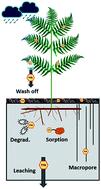当前位置:
X-MOL 学术
›
Environ. Sci.: Processes Impacts
›
论文详情
Our official English website, www.x-mol.net, welcomes your
feedback! (Note: you will need to create a separate account there.)
A novel model concept for modelling the leaching of natural toxins: results for the case of ptaquiloside.
Environmental Science: Processes & Impacts ( IF 4.3 ) Pub Date : 2020-07-20 , DOI: 10.1039/d0em00182a D B García-Jorgensen 1 , H C B Hansen , P Abrahamsen , E Diamantopoulos
Environmental Science: Processes & Impacts ( IF 4.3 ) Pub Date : 2020-07-20 , DOI: 10.1039/d0em00182a D B García-Jorgensen 1 , H C B Hansen , P Abrahamsen , E Diamantopoulos
Affiliation

|
Phytotoxins are a large class of highly diverse emerging environmental contaminants that have been detected at high concentrations in plants, water and soils. This study presents a novel modelling approach for assessing the fate of plant toxins in the soil–plant–atmosphere continuum, developed for the specific case of ptaquiloside (PTA), a carcinogenic phytotoxin produced by Pteridium aquilinum. The mechanistic model DAISY has been adapted for reproducing phytotoxin dynamics in plants, covering processes such as toxin generation in the canopy, wash off by precipitation and toxin recovery in the canopy after depletion events. Transport of the toxin in the soil was simulated by the advection–dispersion equation assuming weak sorption and degradation for two Danish soils. The model simulates realistic toxin contents in the plant during the growing season, where the actual PTA content is dynamic and a function of the biomass. An average of 48% of the PTA produced in the canopy is washed off by precipitation, with loads in the soil often in the order of mg m−2 and up to a maximum of 13 mg m−2 in a single rain event. Degradation in the soil removes 99.9% of the total PTA input to the soil, while only 0.1% leaches into the soil. The median annual flux-averaged predicted environmental concentrations during single events are often in the order of μg L−1, reaching up to 60 μg L−1 for the worst-case scenario. The simulated results for both degradation and wash off are of the same order of magnitude as the published data. Based on the results, we conclude that DAISY, with the newly implemented processes, is a useful tool for understanding, describing and predicting the fate of PTA in the soil. Further work comparing the model results with real data is needed for the calibration and validation of the model.
中文翻译:

用于模拟天然毒素浸出的新颖模型概念:帕奎洛甙的结果。
植物毒素是一类高度多样化的新兴环境污染物,已在植物,水和土壤中以高浓度检测到。这项研究提出了一种新的建模方法,评估在土壤-植物-大气连续体的植物毒素的命运,为ptaquiloside的具体情况(PTA),通过产生一种致癌植物毒素开发蕨菜。机械模型DAISY已适应于在植物中重现植物毒素动态,涵盖了诸如冠层中的毒素生成,被沉淀冲刷和耗尽事件后冠层中的毒素回收等过程。通过对流扩散方程模拟土壤中毒素的迁移,假设对两种丹麦土壤的吸附和降解均较弱。该模型模拟植物在生长季节中的实际毒素含量,其中实际的PTA含量是动态的,并且是生物量的函数。冠层平均产生的PTA中有48%被降水冲刷掉,土壤中的负载量通常为mg m -2,最高为13 mg m -2。在一次降雨事件中。土壤中的降解会清除99.9%的PTA投入土壤,而只有0.1%的PTA浸入土壤。单个事件中的年平均通量平均预计环境浓度通常为μgL -1,最坏情况下可达60μgL -1。降解和清洗的模拟结果与已发布数据的数量级相同。根据结果,我们得出结论,DAISY和新实施的流程是了解,描述和预测土壤中PTA命运的有用工具。需要对模型结果与实际数据进行比较的进一步工作,以进行模型的校准和验证。
更新日期:2020-08-19
中文翻译:

用于模拟天然毒素浸出的新颖模型概念:帕奎洛甙的结果。
植物毒素是一类高度多样化的新兴环境污染物,已在植物,水和土壤中以高浓度检测到。这项研究提出了一种新的建模方法,评估在土壤-植物-大气连续体的植物毒素的命运,为ptaquiloside的具体情况(PTA),通过产生一种致癌植物毒素开发蕨菜。机械模型DAISY已适应于在植物中重现植物毒素动态,涵盖了诸如冠层中的毒素生成,被沉淀冲刷和耗尽事件后冠层中的毒素回收等过程。通过对流扩散方程模拟土壤中毒素的迁移,假设对两种丹麦土壤的吸附和降解均较弱。该模型模拟植物在生长季节中的实际毒素含量,其中实际的PTA含量是动态的,并且是生物量的函数。冠层平均产生的PTA中有48%被降水冲刷掉,土壤中的负载量通常为mg m -2,最高为13 mg m -2。在一次降雨事件中。土壤中的降解会清除99.9%的PTA投入土壤,而只有0.1%的PTA浸入土壤。单个事件中的年平均通量平均预计环境浓度通常为μgL -1,最坏情况下可达60μgL -1。降解和清洗的模拟结果与已发布数据的数量级相同。根据结果,我们得出结论,DAISY和新实施的流程是了解,描述和预测土壤中PTA命运的有用工具。需要对模型结果与实际数据进行比较的进一步工作,以进行模型的校准和验证。











































 京公网安备 11010802027423号
京公网安备 11010802027423号